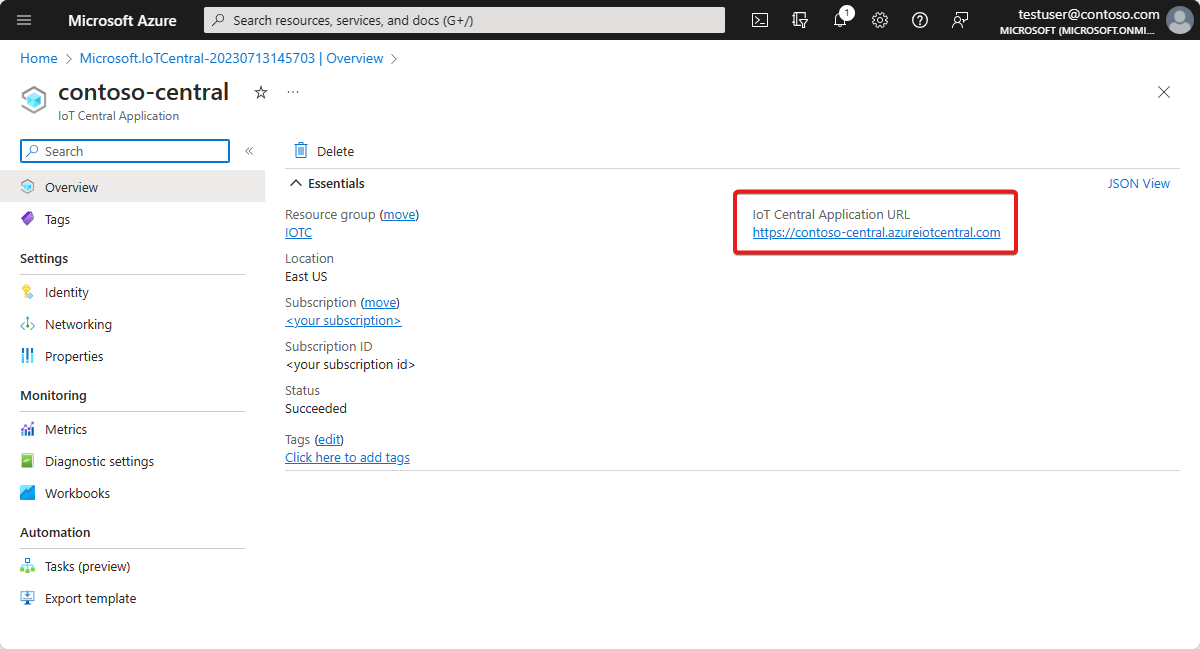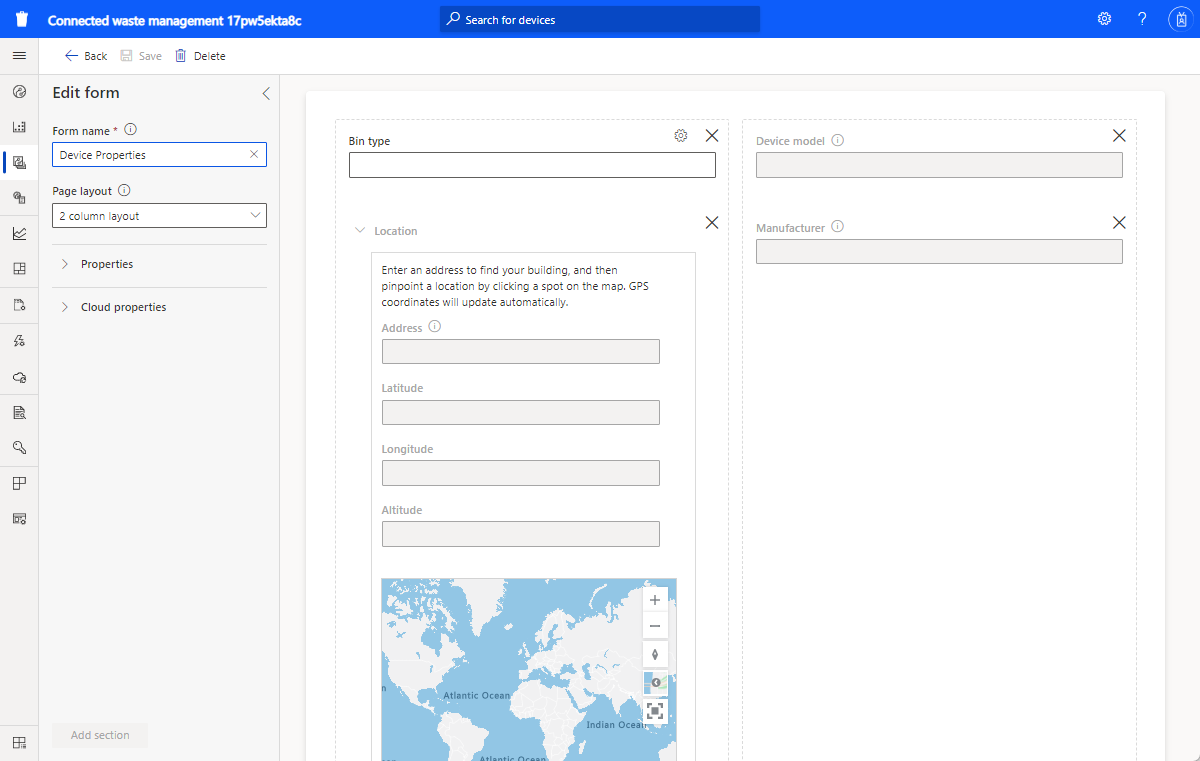Tutorial: Deploy and walk through the connected waste management application template
The connected waste management application template helps you kickstart your IoT solution development to remotely monitor to maximize efficient waste collection as part of a smart city.

Devices and connectivity (1,2)
Devices such as waste bins that are used in open environments may connect through low-power wide area networks or through a third-party network operator. For these types of devices, use the Azure IoT Central Device Bridge to send your device data to your IoT Central application. You can also use an IP capable device gateway that connects directly to your IoT Central application.
IoT Central
Azure IoT Central is an IoT App platform that helps you quickly build and deploy an IoT solution. You can brand, customize, and integrate your solution with third-party services.
When you connect your smart waste devices to IoT Central, the application provides:
- Device command and control.
- Monitoring and alerting.
- A user interface with built-in role-based access controls.
- Configurable dashboards.
- Extensibility options.
Extensibility and integrations (3)
You can extend your IoT application in IoT Central and optionally:
- Transform and integrate your IoT data for advanced analytics through data export from your IoT Central application.
- Automate workflows in other systems by triggering actions using Power Automate or webhooks from IoT Central application.
- Programmatically access your IoT Central application by using the IoT Central REST APIs.
Business applications (4)
You can use IoT data to power various business applications within a waste utility. For example, in a connected waste management solution you can optimize the dispatch of trash collections trucks. The optimization can be done based on IoT sensors data from connected waste bins. In your IoT Central connected waste management application, you can configure rules and actions and set them to create alerts in Connected Field Service. Configure Power Automate in IoT Central rules to automate workflows across applications and services. Additionally, based on service activities in Connected Field Service, information can be sent back to Azure IoT Central.
You can easily configure the following integration processes with IoT Central and Connected Field Service:
- Azure IoT Central can send information about device anomalies to Connected Field Service for diagnosis.
- Connected Field Service can create cases or work orders triggered from device anomalies.
- Connected Field Service can schedule technicians for inspection to prevent the downtime incidents.
- Azure IoT Central device dashboard can be updated with relevant service and scheduling information.
In this tutorial, you learn how to:
- Use the Azure IoT Central connected waste management application template to create your app.
- Explore and customize the dashboard.
- Explore the connected waste bin device template.
- Explore simulated devices.
- Explore and configure rules.
- Configure jobs.
- Customize your application branding.
Prerequisites
An active Azure subscription. If you don't have an Azure subscription, create a free account before you begin.
Create connected waste management application
To create your IoT Central application:
Navigate to the Create IoT Central Application page in the Azure portal. If prompted, sign in with your Azure account.
Enter the following information:
Field Description Subscription The Azure subscription you want to use. Resource group The resource group you want to use. You can create a new resource group or use an existing one. Resource name A valid Azure resource name. Application URL The URL subdomain for your application. The URL for an IoT Central application looks like https://yoursubdomain.azureiotcentral.com.Template Connected Waste Management Region The Azure region you want to use. Pricing plan The pricing plan you want to use. Select Review + create. Then select Create.
When the app is ready, you can navigate to it from the Azure portal:

To learn more, see Create an Azure IoT Central application.
Walk through the application
The following sections walk you through the key features of the application:
Dashboard
After you deploy the application template, your default dashboard is Wide World waste management dashboard.
As a builder, you can create and customize views on the dashboard for operators.
Note
All data shown in the dashboard is based on simulated device data, which you see more of in the next section.
The dashboard consists of different tiles:
Wide World Waste utility image tile: The first tile in the dashboard is an image tile of a fictitious waste utility, "Wide World Waste." You can customize the tile and put in your own image, or you can remove it.
Waste bin image tile: You can use image and content tiles to create a visual representation of the device that's being monitored, along with a description.
Fill level KPI tile: This tile displays a value reported by a fill level sensor in a waste bin. Fill level and other sensors, like odor meter or weight in a waste bin, can be remotely monitored. An operator can take an action such as dispatching a trash collection truck.
Waste monitoring area map: This tile uses Azure Maps, which you can configure directly in Azure IoT Central. The map tile displays device location. Try to hover over the map and try the controls over the map, like zoom-in, zoom-out, or expand.
Fill, odor, weight level bar chart: You can visualize one or multiple kinds of device telemetry data in a bar chart. You can also expand the bar chart.
Field Services: The dashboard includes a link to "How to integrate with Dynamics 365 Field Services from your Azure IoT Central application." For example, you can use Field Services to create tickets for dispatching trash collection services.
Customize the dashboard
You can customize the dashboard by selecting the Edit menu. Then you can add new tiles or configure existing ones. Here's what the dashboard looks like in editing mode:
You can also select + New to create a new dashboard and configure from scratch. You can have multiple dashboards, and you can switch between your dashboards from the dashboard menu.
Explore the device template
A device template in Azure IoT Central defines the capabilities of a device, which can include telemetry, properties, or commands. As a builder, you can define device templates that represent the capabilities of the devices you will connect.
The connected waste management application comes with a sample template for a connected waste bin device.
To view the device template:
In Azure IoT Central, from the left pane of your app, select Device templates.
In the Device templates list, select Connected Waste Bin.
Examine the device template capabilities. You can see that it defines sensors like Fill level, Odor meter, Weight, and Location.
Customize the device template
Try to customize the following features:
- From the device template menu, select Customize.
- Find the Odor meter telemetry type.
- Update the Display name of Odor meter to Odor level.
- Try to update the unit of measurement, or set Min value and Max value.
- Select Save.
Add a cloud property
To add a cloud property:
- Navigate to the Connected Waste Bin device template, and select + Add capability.
- Add a new cloud property by selecting Cloud Property as Capability type. In Azure IoT Central, you can add a property that is relevant to a device but that doesn't come from the device. For example, a cloud property might be an alerting threshold specific to installation area, asset information, or maintenance information.
- Select Save.
Views
The connected waste bin device template comes with predefined views. Explore the views, and update them if you want to. The views define how operators see the device data and input cloud properties.
Publish
If you made any changes, remember to publish the device template.
Create a new device template
To create a new device template, select + New, and follow the steps. You can create a custom device template from scratch, or you can choose a device template from the list of featured device templates.
Explore simulated devices
In Azure IoT Central, you can create simulated devices to test your device template and application.
The connected waste management application has two simulated devices associated with the connected waste bin device template.
View the devices
Explore the Device Properties and Device Dashboard tabs.
Note
All the tabs have been configured from the device template views.
Add new devices
You can add new devices by selecting + New on the Devices tab.
Explore and configure rules
In Azure IoT Central, you can create rules to automatically monitor device telemetry, and to trigger actions when one or more conditions are met. The actions might include sending email notifications, triggering an action in Power Automate, or starting a webhook action to send data to other services.
The connected waste management application has four sample rules.
View rules
From the left pane of Azure IoT Central, select Rules.
Select Bin full alert.
The Bin full alert checks the following condition: Fill level is greater than or equal to Bin full alert threshold.
The Bin full alert threshold is a cloud property that's defined in the connected waste bin device template.
Now create an email action.
Create an email action
In the Actions list of the rule, you can configure an email action:
- Select + Email.
- For Display name, enter High pH alert.
- For To, enter the email address associated with your Azure IoT Central account.
- Optionally, enter a note to include in the text of the email.
- Select Done > Save.
You'll now receive an email when the configured condition is met.
Note
The application sends email each time a condition is met. Disable the rule to stop receiving email from the automated rule.
To create a new rule, from the left pane of Rules, select +New.
Configure jobs
In Azure IoT Central, jobs allow you to trigger device or cloud properties updates on multiple devices. You can also use jobs to trigger device commands on multiple devices. Azure IoT Central automates the workflow for you.
- From the left pane of Azure IoT Central, select Jobs.
- Select +New, and configure one or more jobs.
Customize your application
As an administrator, you can change settings to customize the user experience in your application.
Select Customization > Appearance, and then:
- To set the masthead logo image, select Change.
- To set the browser icon image that appears on browser tabs, select Change.
- Under Browser colors, you can replace the default browser colors by adding HTML hexadecimal color codes. For more information about color notation for HEX values, see the W3Schools HTML Colors tutorial.
You can change the application image on the Application > Management page.
Clean up resources
If you don't plan to continue using this application, you can delete it:
- In your Azure IoT Central application, go to Application > Management.
- Select Delete, and then confirm your action.






